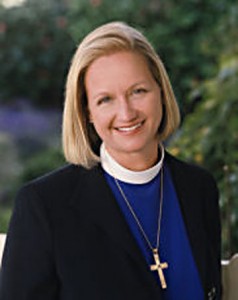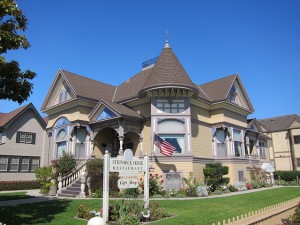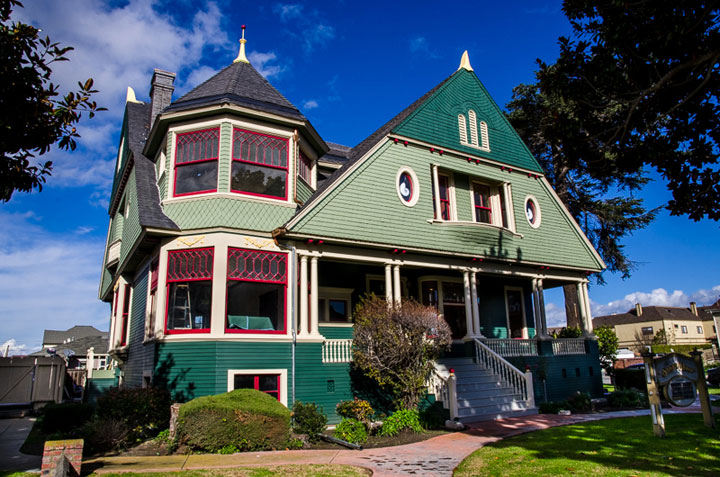John Steinbeck’s childhood church’s headquarters and his boyhood home in Salinas, California are now neighbors. Earlier this month the Diocese of El Camino Real, the administrative division of the Episcopal Church that includes Salinas and Monterey, moved its headquarters from a modern office building near Monterey to the B.V. Sargent House, built in 1896 and located at 154 Central Avenue, only three blocks from the 1897 home where John Steinbeck was baptized in 1905. Since 1974 the John Steinbeck House at 132 Central Avenue has been operated as a restaurant and history-minded visitor destination by the Valley Guild, a non-profit group. Before its purchase by the regional Episcopal Church, the more opulent Sargent House was the address of a local law firm, although its distinctive stained-glass windows and John-Steinbeck-played-here past are among its memorable characteristics. John Steinbeck’s corner home was constructed in the Queen Anne Victorian style popular in architectural pattern books of the time. The imaginative architect William Weeks chose the less traditional Modified Colonial style when he designed the Sargent House, originally occupying an entire block, for its prominent owner. John Steinbeck’s father Ernst was the treasurer of Monterey County. Bradley Sargent Sr. was a county supervisor and state senator. His son Bradley Sargent Jr. became Monterey County’s district attorney and a superior court judge.
John Steinbeck’s father Ernst was the treasurer of Monterey County. Bradley Sargent Sr. was a county supervisor and state senator.
 The Diocese of El Camino Real serves Episcopal churches throughout Steinbeck Country, from Silicon Valley to the San Luis Obispo area. Commenting on the symbolism of the move to Salinas, the Rt. Rev. Mary Gray-Reeves, the vibrant bishop who speaks fluent Spanish, explained: “We needed a site that was centrally located within our diocese, but we also wanted to make a statement in the City of Salinas by our presence. Buildings do speak in a community. We are in the midst of not only government and commercial buildings, but we as a church will be in the midst of the struggles of real life. Sargent House is one of the grand old homes of Salinas and it stands beautifully in the diocese, a witness to our commitment and ministry.” Whether divinely ordained or simple coincidence, however, the sudden proximity of the not-for-profit entities now housed in the pair of historic properties in the heart of Steinbeck’s hometown has special meaning for Steinbeck lovers everywhere.
The Diocese of El Camino Real serves Episcopal churches throughout Steinbeck Country, from Silicon Valley to the San Luis Obispo area. Commenting on the symbolism of the move to Salinas, the Rt. Rev. Mary Gray-Reeves, the vibrant bishop who speaks fluent Spanish, explained: “We needed a site that was centrally located within our diocese, but we also wanted to make a statement in the City of Salinas by our presence. Buildings do speak in a community. We are in the midst of not only government and commercial buildings, but we as a church will be in the midst of the struggles of real life. Sargent House is one of the grand old homes of Salinas and it stands beautifully in the diocese, a witness to our commitment and ministry.” Whether divinely ordained or simple coincidence, however, the sudden proximity of the not-for-profit entities now housed in the pair of historic properties in the heart of Steinbeck’s hometown has special meaning for Steinbeck lovers everywhere.
‘Sargent House is one of the grand old homes of Salinas and it stands beautifully in the diocese, a witness to our commitment and ministry.’
 When John Steinbeck was confirmed by a visiting bishop from Nevada at St. Paul’s Episcopal Church one hundred years ago, Salinas, California was a small town of 2,500, mostly white citizens, and the Episcopal church was a social center for prominent families like the Steinbecks. Today the city’s population of 150,000-plus is largely Hispanic, and St. Paul’s Episcopal Church celebrates services in both English and in Spanish. The old St. Paul’s Episcopal Church building that John Steinbeck knew as a boy is gone, and the ultra-modern National Steinbeck Center—located within walking distance of the Steinbeck and Sargent Houses—may become the property of California State University Monterey Bay in a deal negotiated with Salinas, California taxing authorities. Like the Episcopal Church in the United States, the City of Salinas, California struggles with questions of economics, identity, and inclusiveness posed by John Steinbeck in his writing. During his lifetime he said he didn’t want anything fancy named for him by his hometown. But it’s likely he’d be pleased with hopeful signs of progress in Salinas—and that he’d welcome Central California’s Episcopal Church headquarters to the neighborhood where he played while growing up there.
When John Steinbeck was confirmed by a visiting bishop from Nevada at St. Paul’s Episcopal Church one hundred years ago, Salinas, California was a small town of 2,500, mostly white citizens, and the Episcopal church was a social center for prominent families like the Steinbecks. Today the city’s population of 150,000-plus is largely Hispanic, and St. Paul’s Episcopal Church celebrates services in both English and in Spanish. The old St. Paul’s Episcopal Church building that John Steinbeck knew as a boy is gone, and the ultra-modern National Steinbeck Center—located within walking distance of the Steinbeck and Sargent Houses—may become the property of California State University Monterey Bay in a deal negotiated with Salinas, California taxing authorities. Like the Episcopal Church in the United States, the City of Salinas, California struggles with questions of economics, identity, and inclusiveness posed by John Steinbeck in his writing. During his lifetime he said he didn’t want anything fancy named for him by his hometown. But it’s likely he’d be pleased with hopeful signs of progress in Salinas—and that he’d welcome Central California’s Episcopal Church headquarters to the neighborhood where he played while growing up there.


